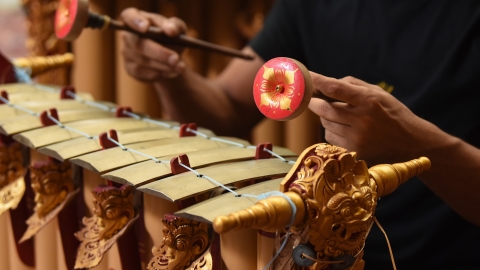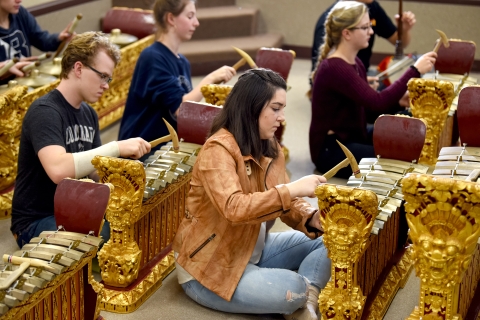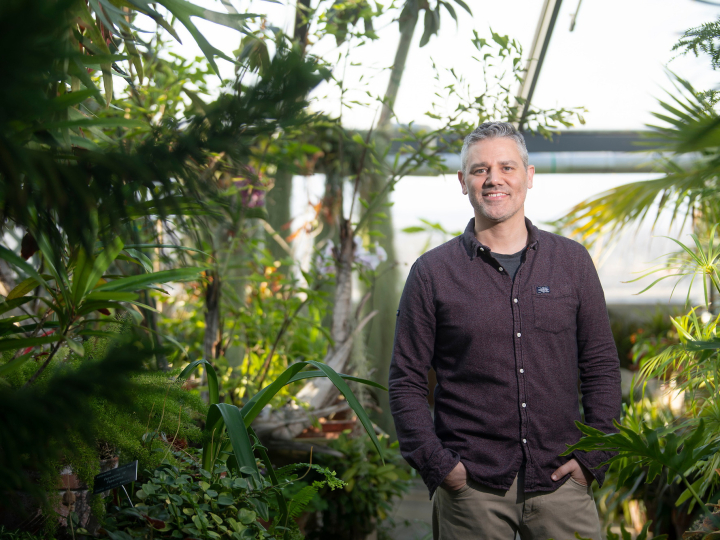
Virtual Instrument Helps Bucknell Gamelan Ensemble Play On
May 7, 2020
Bucknell's Gamelan Ensemble consists of more than two dozen instruments played by nearly 20 student musicians. Emily Paine, Communications
James Howe '23 had never considered himself a musical person, but he wanted his college experience to be about stepping outside his comfort zone. After taking a crash course in the gamelan as part of the Arts First Pre-Orientation program, Howe decided to go out on a limb and jumped at the chance to play in the Bucknell Gamelan Ensemble.
"Gamelan unlocked an interest in non-Western music that I didn't have before, and it was a great opportunity to hang out with people I had met who shared that," says Howe, a computer engineering major from Greenwich, Conn.
This semester, Howe continued to feed that interest and build on those connections, even after returning home due to the COVID-19 pandemic. It was all possible thanks to an innovative tool developed by a Bucknell alumna: an interactive virtual gamelan.
The gamelan is a traditional Indonesian orchestra made up of mostly percussion instruments, including metallophones, chimes, gongs and drums. Bucknell's gamelan consists of more than two dozen intricately carved red and gold instruments played by nearly 20 student musicians. Students learn to play fast-paced, intersecting parts by ear, which means no previous musical training is needed to be part of the ensemble.

Students learn to play gamelan instruments by ear, without the aid of sheet music. Emily Paine, Communications
Abby Dolan '19 created the virtual gamelan as a Digital Scholarship Summer Research Fellow at Bucknell. As an ensemble member herself, Dolan wanted to build a tool that helped new learners become familiar with the instruments outside the classroom. The website she designed allowed users to click on various parts of the instruments to hear audio samples.
While it served as a good introduction to the gamelan, the tool wasn't suited to everyday practice. When Gamelan Ensemble Director Bethany Collier, music, reached out about updating the instruments for current students, Dolan was happy to help.
"I couldn't imagine being in the position that these students were in, where they had no capability to participate in this activity they enjoy," says Dolan, who graduated with dual degrees in music and English. "Gamelan was such an integral thing for me at Bucknell, so it was important to help current students be part of the ensemble throughout the spring, even if they couldn't be on campus together."
The new tool includes five downloadable instrument applications. To play, students use number and letter keys on their computers to ring and mute notes, which simulates the striking and dampening of metallophone keys.
Collier provided a video of herself performing the melody of an orchestral piece and asked ensemble members to screen record themselves playing their respective parts. The result, she says, serves as an exciting example of Bucknellians’ ability to adapt and innovate in extraordinary circumstances.
"It's inspiring to see that a past undergraduate student project is becoming useful two years later, especially in a time of national crisis," Collier says. "It speaks not only to the utility of digital tools in our world today, but also to how important and relevant the work our undergraduate research students do at Bucknell really is."
For students like Howe, the virtual gamelan not only kept him practicing — it also kept him connected.
"I've made a lot of friendships through the ensemble, and it was really important for me to keep in touch with them through all this," he says. "Having an alum work to make that possible for us just shows how amazingly connected this community is."

